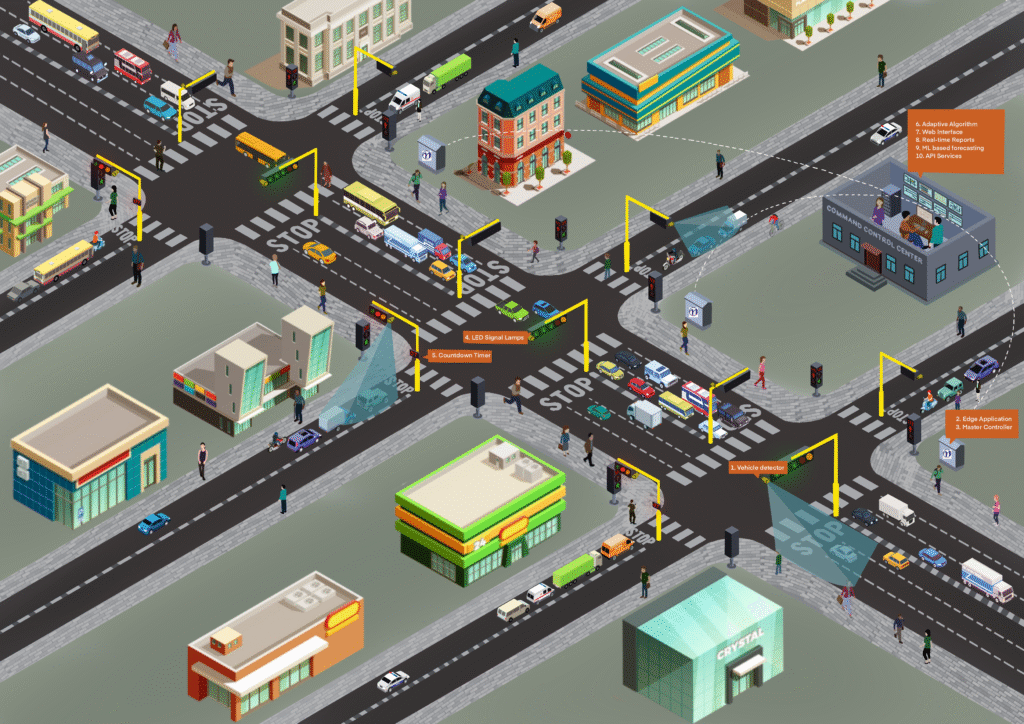Adaptive Traffic Control System (ATCS)
AI-Powered Traffic Control Reducing Congestion and Emissions
Adaptive Traffic Control System (ATCS) is an AI-driven traffic management solution designed to optimize urban mobility in real time. Unlike traditional traffic signals, ATCS continuously monitors vehicle flow, traffic density, and pedestrian movement.
By dynamically adjusting signal timings based on current road conditions, ATCS reduces congestion, shortens waiting times, and improves overall road safety. Its also prioritize emergency vehicles, ensure smoother main routes through green corridor optimization, and provide actionable insights for traffic planning and infrastructure development.
With a centralized command dashboard, city authorities can monitor multiple intersections simultaneously, detect incidents in real time, and receive alerts for proactive response. The system is scalable, energy-efficient, and data-driven, making it a future-ready solution for smart cities looking to enhance mobility, reduce emissions, and improve citizen safety.

Key Features
Adaptive Signal Control
Dynamically adjusts traffic signals in real time based on traffic flow
Real-Time Traffic Analytics
Continuously monitors vehicle density and road conditions
Green Corridor Optimization
Prioritizes main routes to reduce congestion and improve transit times
Incident Detection & Response
Detects accidents or blockages and alerts authorities instantly
Retrofit Friendly
Designed to integrate seamlessly with existing infrastructure, minimizing downtime and upgrade costs.
Pedestrian & Cyclist Safety
Integrates smart crossings and sensors to protect vulnerable road users
Centralized Monitoring
Manage multiple intersections from a single command dashboard
Integration Friendly
Easily connects with third-party systems like ERP, HRMS, and incident management tools for unified workflows.
Data Logging & Reporting
Provides historical traffic data for planning and analysis
Benefits of ATCS
Optimized Traffic Flow
Reduces congestion and waiting times at intersections, ensuring smoother vehicle movement throughout the city
Enhanced Road Safety
Protects drivers, pedestrians, and cyclists by intelligently managing signals and preventing traffic conflicts.
Scalable
Can be easily expanded across multiple intersections, adapting seamlessly to growing urban traffic demands
Faster Emergency Response
Prioritizes emergency vehicles at intersections, enabling quicker access and reducing critical response times
Improved Citizen Satisfaction
Reduces frustration from traffic jams and waiting times, improving overall public experience
Sustainable Urban Mobility
Helps cities meet environmental goals by reducing congestion-related emissions and fuel consumption
Energy Efficiency
Minimizes vehicle idling and unnecessary stops, lowering emissions and reducing overall fuel consumption
Data-driven Decision Making
Empowers city authorities with actionable insights and analytics for effective urban traffic management and decision-making
Reduced Travel Time
Ensures smoother journeys for commuters by dynamically adapting to real-time traffic conditions





